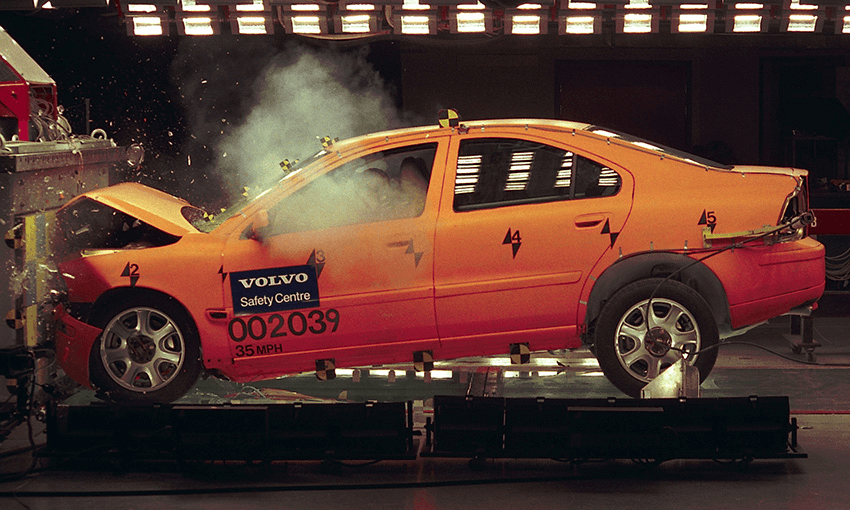Sixty years ago Volvo invented the modern seatbelt then gave it away free to the world. Now, to celebrate that anniversary, they’re doing it again – this time with millions of dollars of hard-won safety research.
In a steel tunnel in Sweden, a giant rubber moose is in trouble. Watched from every angle by high-speed cameras, the moose dangles side-on just above the ground, suspended atop a glass-roofed pit.
Poised opposite the moose is a brand new Volvo, idling with a dummy in the driver seat. There’s a blaring signal and the car hurtles towards the moose, accelerating as it goes, smashing straight into the beast’s legs. The moose explodes, rolling up and over the bonnet, destroying the windscreen and bounces broken onto the ground. It’s a perfect hit. A great success.
In the past two decades, more than 400 cars a year have been crashed, smashed, crushed and flipped at the Volvo Crash Centre outside Gothenburg. The facility, constructed at the start of the century at a cost of almost $100m, is comprised of two 100m long tunnels and an 850-ton steel-encased block. By rotating the smaller of the two tunnels – the only movable one of its kind – Volvo can manipulate the angle of their test cars and simulate everything from fender-benders to devastating head-on collisions.
The data has informed Volvo’s industry-leading safety technology which sees the company ambitiously pursuing ‘Vision 2020’, a target to have nobody killed or seriously injured in a Volvo from the year 2020 onwards. And now, as part of their E.V.A initiative they’re giving it all away for free, just like they did with their most significant invention 60 years ago.
“Not sharing this technology would be a cardinal sin,” says James Moore, Volvo’s national training manager. “We don’t regret giving away the seatbelt – and that’s saved more than a million lives.”
The story goes like this: In 1958, Volvo engineer Nils Bohlin developed the first V-type, three-point seatbelt, drastically improving on the previous lap-belt design which did nothing to restrain the torso of an occupant. Bohlin, an engineer who had formerly designed ejector seats for jets, was working under the guidance of Volvo doyen Gunnar Engellau, who poached him from Saab as part of his efforts to cement Volvo as the vehicle of choice for the safety-conscious driver. Volvo patented Bohlin’s design in 1959, installing the belts in their Amazon and PV 544 models – and immediately made their invention free to the world.
Volvo’s gift was a prudent move from the chief executive, firmly placing the company at the centre of the safety discussion, but it was also an altruistic one: Engellau was said to be mourning the death of a family member killed in a car crash. By 1967, a study of more than 28,000 crashes conducted by Bohlin showed zero fatalities of belted occupants at speeds below 60mph/96kmh. And a decade after giving their signature invention away, Engellau had transformed Volvo into an industry behemoth, achieving revenue of more than $1b.
Dr Lotta Jakobson, Volvo’s senior technical leader of safety, calls it the most important invention in the history of automotive safety.
“The idea of sharing knowledge and innovation with the industry and research community for safer roads goes hand-in-hand with the way we develop safety technologies,” she says.
And that spirit is embedded in everything Volvo does today, says Moore: “We start with safety, and we build the car around that.”
That means safety for everyone who gets inside a Volvo, not just the average driver. Since the mid-90s Volvo have experimented with a wide range of crash test dummies, starting with the only available small-sized female ‘frontal impact’ dummy in 1995. In 2001 Volvo employed a smaller ‘side-impact’ dummy to study the outcomes of side-on crashes. That was followed by a virtual model of a pregnant woman in the early 2000s and a bigger model to test the effects of whiplash a decade later.
Women are more likely to be injured in car accidents for several reasons, Moore says. One of the reasons is that the majority of the crash test dummies used in industry tests represent males, as does the biomechanical data that car manufacturers model their designs around. Differences in anatomy, neck strength and flexibility also mean that women are more likely to suffer from whiplash injuries, and thus need different precautions, Volvo have found.
Dr Jakobsson says Volvo is prioritising safety for the full spectrum of humanity, not just the ‘average driver’. “We are doing our very best to make our cars equally safe for all people irrespective of gender, height, weight or shape.”
Right now, over 100 research papers based on Volvo’s biomechanically-diverse experiments are available on their website, totally free to rival manufacturers and academics. The digital library includes research on whiplash injuries, chest injuries, head injuries, spinal injuries, as well as papers on child safety. The database also holds analysis from 43,000 real-life crashes, providing comprehensive information about why an accident happened and what injuries were caused. The findings have been consistently iterated into Volvo’s vehicle design, earning the manufacturer an international reputation for safety. Their vehicles have been so carefully constructed they’re often known colloquially as tanks.
But the brand new XC90 sitting on a sleek shop floor in Auckland’s Greenlane is anything but unwieldy. Rather, the luxury SUV radiates that typically-Scandinavian design you can imagine aficionados speaking of in hushed, reverential tones.
Moore traces the curves of the body, composed of 40% ultra high-strength boron steel, which is so strong Volvo provides specialist advice on how to extricate passengers from their vehicles with the Jaws of Life. The engine, mounted sideways, creates a buffer zone which seems to stretch for miles. The vehicle is fitted with head restraints, not headrests – a feature born of the female crash dummy research. And in a crash, inflatable curtains fall from the roof, protecting young heads from the door frame.The thousands of vehicles destroyed in Gothenburg have all led to a near-impervious design.
But Volvo is going one step further, protecting the people outside the car as well as those within. Around 1.3m people a year are killed by vehicles globally, about half of them pedestrians, cyclists and people on motorbikes, and Volvo want to keep them safe too. City Safety utilises machine learning and powerful sensors to automatically apply the brakes ahead of a collision The system can also preemptively apply the steering controls to avoid hitting a pedestrian, and monitors movement around the vehicle, 360 degrees, in real time.
“It’s about going from passive safety, to active safety, to proactive safety,” says Moore.
From the days of Nils Bohlin, Volvo’s safety protocols have evolved year on year to a space-age system informed by the research gleaned from the wreckage of the thousands of cars of the crash centre. And while their tradition of giving remains at the forefront of the company’s ethos with the E.V.A initiative, Bohlin’s creation still sits squarely at the centre of safety today. Despite all the technological advances in safety, any time you get into any car, the first thing you do is put on his three-point seatbelt.
“There is a little bit of Nils Bohlin in every car,” said his 2002 obituary.
And there’s good news for fake moose – Volvo plan to cease crashing test cars entirely when Vision 2020 is reached.
This content was created in paid partnership with Volvo. Learn more about our partnerships here.

